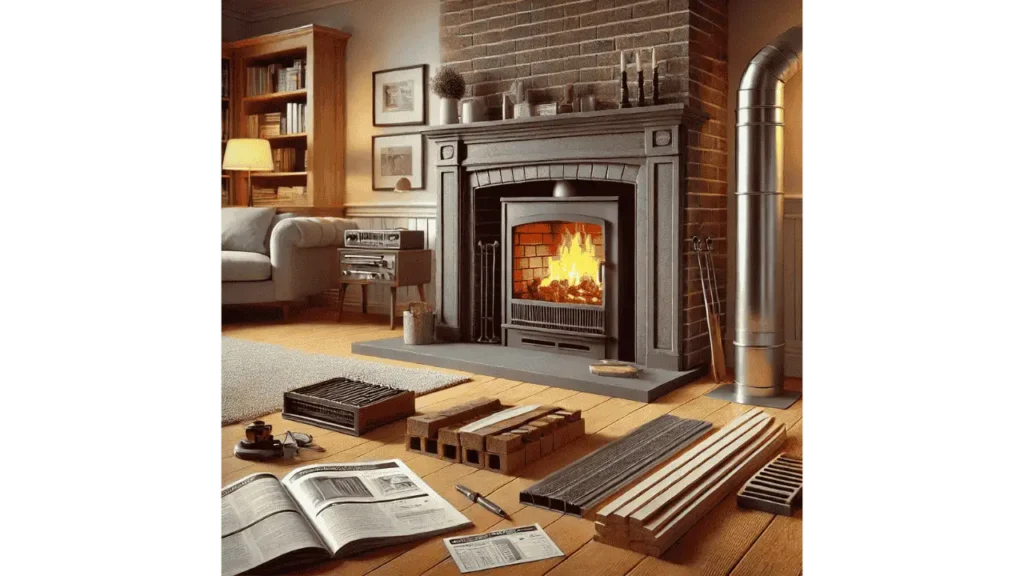Switching from a gas fireplace to a wood-burning one can feel like a big decision, especially with the extra costs and maintenance involved. I’ve considered this change myself, drawn by the authentic crackle and warmth of a wood fire. The good news is, with professional help and the right preparation, the conversion is possible and safe. In this guide, we’ll cover everything from safety considerations to the conversion process, costs, and what to expect with maintenance.
Convert Gas to Wood Fireplace: The Dos and Don’ts
Converting a gas fireplace to a wood-burning one is possible, but it requires careful planning and professional help to ensure safety and compliance with local codes. The process often involves checking if the existing chimney can handle wood smoke, removing gas components, and possibly restoring features like a damper. I’ve looked into this option myself, and while it’s exciting to think about the crackle of real wood, it’s not as simple as just adding logs to a gas setup. In this guide, we’ll explore what’s involved, key considerations, and how to make the switch safely and effectively.
Is it Bad to Burn Wood Logs in a Gas Fireplace?
Yes, burning wood logs in a gas fireplace is unsafe and not recommended. Gas fireplaces are not built to handle the high heat, soot, and smoke from wood fires, which can damage components and create serious safety risks. I once considered trying this for a quick fix, but after learning about the potential fire hazards and chimney issues, I quickly ruled it out. If you want to switch to wood burning, a proper conversion is essential.
Is Gas to Wood Conversion Possible?
Converting a gas fireplace to a wood-burning one is possible, but it depends on the fireplace and chimney setup. Not all gas fireplaces are designed for wood-burning, so the first step is determining if your existing structure can handle the heat and smoke of a wood fire. A professional inspection can confirm if your chimney is lined, properly vented, and meets safety standards for a wood-burning system.
Consider Conversion
If your gas fireplace is a retrofit into an old wood-burning unit, conversion may be simpler. In this case, you might just need to remove the gas components and restore the original wood-burning features. However, if your gas fireplace was built as a ventless or direct vent model, converting to wood burning would require significant changes, including replacing the entire fireplace and ensuring the chimney is fully functional.
How to Change from Gas to Wood Burning Fireplace?
Switching from a gas fireplace to a wood-burning one requires careful planning and the help of a professional. Here are five key steps to ensure a safe and successful conversion:
Step 1: Inspect the Chimney
Have a certified chimney sweep or technician inspect your chimney to ensure it’s safe for wood burning. They’ll check for proper lining, structural integrity, and venting capabilities to handle smoke and heat.
Step 2: Remove Gas Components
All gas components, including burners, gas lines, and control systems, must be safely removed by a licensed professional. This step prevents any lingering gas leaks and ensures compliance with local codes.
Step 3: Restore the Damper and Firebox
If the original damper and firebox were modified for the gas insert, they’ll need to be restored. This includes ensuring the damper can regulate airflow and the firebox is large and durable enough for wood fires.
Step 4: Install a Chimney Liner (if needed)
If the chimney lacks a proper liner or the existing one is damaged, a new liner must be installed. Chimney liners protect the structure from heat and prevent creosote buildup, ensuring safer wood burning.
Step 5: Test and Inspect
Once the conversion is complete, a thorough test and final inspection should be conducted by a professional to ensure everything is functioning safely. This step guarantees that your new wood-burning fireplace is ready to use. Don’t worry: you still can convert your wood burning fireplace back to the gas one with this guide here!
How Much Does Fireplace Conversion Cost?
The cost of converting a gas fireplace to a wood-burning one depends on several factors, including the condition of your chimney and the extent of work required. On average, the conversion can range from $1,000 to $5,000, including labor and materials. Additional costs may apply for structural repairs or chimney relining. Let’s explore one important aspect of wood-burning fireplaces:
The Chimney Maintenance of Wood Fireplaces
Wood fireplaces require regular chimney maintenance to prevent creosote buildup, which is a fire hazard. Annual inspections and cleanings by a certified chimney sweep are essential to maintain safety and efficiency. While gas fireplaces are low-maintenance, switching to wood burning means committing to more frequent upkeep. If you’re prepared for the added care, the warmth and ambiance of real wood fires can be worth it.
Final Takeaways
Converting a gas fireplace to a wood-burning one is possible with proper planning, professional help, and an understanding of maintenance needs. While it involves effort and costs, the charm of a real wood fire can make it worthwhile for many homeowners. With a safe and thoughtful approach, you can enjoy the crackle and warmth of a traditional wood-burning fireplace in your home.
- 27 Farmhouse Fireplace Ideas That Bring Warmth & Charm - August 18, 2025
- 25 Fireplace Lighting Ideas to Illuminate Your Hearth - August 7, 2025
- How to Replace an Electric Fireplace Switch? - August 5, 2025



